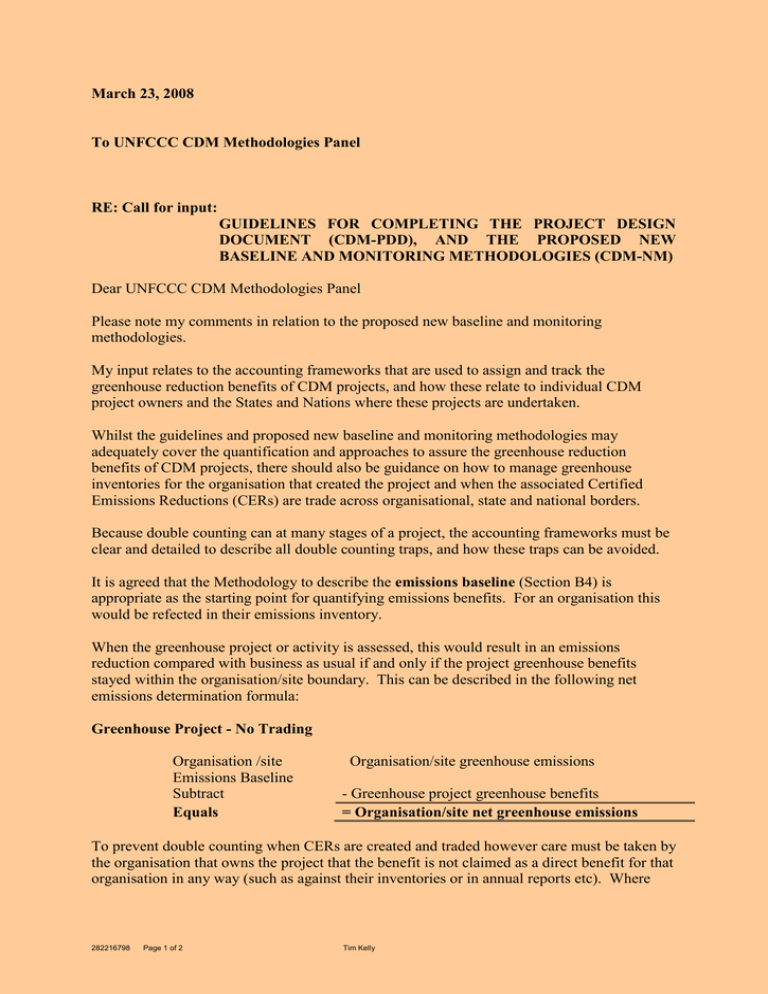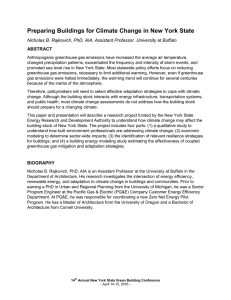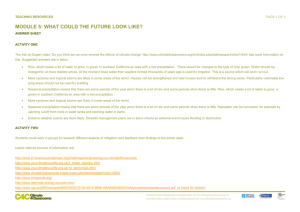March 23, 2008 To UNFCCC CDM Methodologies Panel RE: Call for input:
advertisement

March 23, 2008 To UNFCCC CDM Methodologies Panel RE: Call for input: GUIDELINES FOR COMPLETING THE PROJECT DESIGN DOCUMENT (CDM-PDD), AND THE PROPOSED NEW BASELINE AND MONITORING METHODOLOGIES (CDM-NM) Dear UNFCCC CDM Methodologies Panel Please note my comments in relation to the proposed new baseline and monitoring methodologies. My input relates to the accounting frameworks that are used to assign and track the greenhouse reduction benefits of CDM projects, and how these relate to individual CDM project owners and the States and Nations where these projects are undertaken. Whilst the guidelines and proposed new baseline and monitoring methodologies may adequately cover the quantification and approaches to assure the greenhouse reduction benefits of CDM projects, there should also be guidance on how to manage greenhouse inventories for the organisation that created the project and when the associated Certified Emissions Reductions (CERs) are trade across organisational, state and national borders. Because double counting can at many stages of a project, the accounting frameworks must be clear and detailed to describe all double counting traps, and how these traps can be avoided. It is agreed that the Methodology to describe the emissions baseline (Section B4) is appropriate as the starting point for quantifying emissions benefits. For an organisation this would be refected in their emissions inventory. When the greenhouse project or activity is assessed, this would result in an emissions reduction compared with business as usual if and only if the project greenhouse benefits stayed within the organisation/site boundary. This can be described in the following net emissions determination formula: Greenhouse Project - No Trading Organisation /site Emissions Baseline Subtract Equals Organisation/site greenhouse emissions - Greenhouse project greenhouse benefits = Organisation/site net greenhouse emissions To prevent double counting when CERs are created and traded however care must be taken by the organisation that owns the project that the benefit is not claimed as a direct benefit for that organisation in any way (such as against their inventories or in annual reports etc). Where 282216798 Page 1 of 2 Tim Kelly that organisation has sold the benefit to others, they should only claim that their project has assisted others to reduce their emissions. This can be described in the following way: Greenhouse Project – With CER trading Project/Activity Owner Seller - Organisation /site Emissions Baseline Subtract Equals CDM CER Buyer Buyer Organisation/Nation/ State/Emissions Baseline Subtract Equals Organisation/site greenhouse emissions ZERO, Because the greenhouse project provides no internal organisation or site greenhouse benefit. = Organisation/site net greenhouse emissions Organisation/Nation/State greenhouse gas inventories Purchased CERs. = Organisation/Nation/State greenhouse net greenhouse emissions Description of Influence The Project/Activity Owner has not reduced its emissions from this project in any way but has provided a product for the CDM CER Buyer to reduce their emissions. Despite CDM project meeting the requirements of additionality, reducing emissions below those that “would have occurred in the absence of the registered CDM project activity”, the benefits remain at risk of being lost if the broader greenhouse accounting framework fails to manage how the benefits are traded and claimed. It is critical that with trading, those organisations/sites, Nations and States that have sold CERs to other parties, refrain from counting any benefits of the CDM projects for themselves. This will mean that an organisation that has sold CERs to another party will report baseline greenhouse gas emissions that are higher than their physical emissions. Guidance would be provided to Governments of Nations and States to also refrain from counting the greenhouse benefits of projects where CERs have been exported across their borders. The CDM must provide detailed and transparent guidelines on such matters to prevent carbon leakage, particularly where CDM Project owners have their own carbon liabilities. The CDM and baseline methodologies should however, describe a reasonable approach for CER sellers to inform their stakeholders that they have established a project or projects for other parties to reduce their emissions, as separate from activities to reduce their own emissions. I trust you will consider these points. Kind regards Tim Kelly (Private Citizen) 282216798 Page 2 of 2 Tim Kelly







